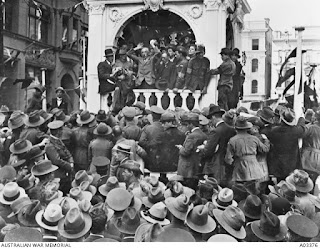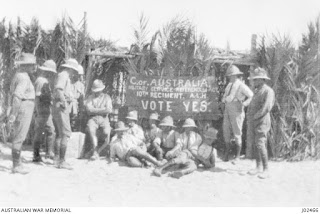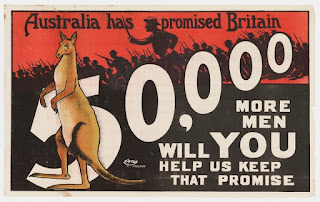 |
| The Victorian Trades Hall surrounded by anti-conscription messages. |
This post takes the opportunity to provide some background information on these plebiscites which played such an important part in Australia's involvement in WW1 as well as information on this new publication.
Background Information on The Conscription Plebiscites
The issue of conscription – compulsory enlistment for military service, particularly for overseas service – has been and remains a contentious issue in Australian life. During 1916 and 1917, two bitter and divisive plebiscites were conducted on this issue.
Plebiscites or Referenda?
The plebiscites are often referred to as referenda but this is not strictly correct.
Under the Australian Constitution provision is made for referenda in order to affect changes to the Constitution itself. An issue put to the vote which does not affect the Constitution is called a plebiscite. A plebiscite is not defined in the Australian Constitution, the Electoral Act or the Referendum Act. Governments can hold plebiscites to test whether people either support or oppose a proposed action on an issue. The government is not bound by the 'result' of a plebiscite as it is by the result of a Constitutional referendum. Federal, state and territory governments have held plebiscites on various issues. Such was the case with the conscription plebiscites held in 1916 and 1917.Thanks to Graeme Hosking for pointing this out.
Compulsory Military Service
Compulsory military service had been part of Australian life before the declaration of war in 1914. Shortly after Federation, the Defence Acts of 1903 and 1904 provided that men between 18 and 60 should be liable for service in time of war, but limited the obligation to service within the Commonwealth and Commonwealth territories. In 1910, Lord Kitchener’s report on Commonwealth defence recommended the introduction of compulsory military training and this was introduced in January 1911. (This was later abolished by the Scullin Labor government in 1929). The referendums, if carried, would have extended this requirement to service overseas.
Australia Goes to War
On 5 August 1914, Australia joined other countries in the British Empire and declared war on Germany. Men quickly enlisted in the Australian Imperial Force (AIF), which was to fight alongside the British Army.
Unlike the major European military forces, the AIF was entirely a volunteer army as compulsory military service was still limited to service inside Australia. Official recruitment began in August with the government initially committing 20,000 troops to the campaign.
By the end of the year, more than 50,000 men had enlisted at a rate of nearly 10,000 per month. Men were enlisting for a number of reasons: patriotism, the excitement of action, travel, and for the pay, which was among the most generous of any Allied army. This pay was particularly attractive as Australia was in the midst of a drought and depression.
However, after news of the disastrous Gallipoli campaign made its way back to Australia, enlistments started to decline.
Billy Hughes and The Somme
William (Billy) Hughes replaced Labor Prime Minister Andrew Fisher who resigned on 27 October 1915. Hughes had publicly stated in July 1915 that he would, ‘in no circumstances … send men out of the country to fight against their will’.
However, in February 1916, Hughes travelled to Europe to consult with British and European governments on Australia’s contribution to the war effort. Just before he left, the British parliament passed conscription legislation, then in May the New Zealand government followed suit and in July the catastrophic Somme offensive in Belgium got underway.
The Somme saw a dramatic increase in Australian troops killed or wounded. In the seven weeks after the attack began, the AIF lost close to 6000 men and another 17,000 wounded. It seemed impossible that the AIF could replace its huge losses through voluntarism alone.
At the same time, enlistments in August were down to 6345 and according to the British War Council the AIF immediately needed a special draft of 20,000 men and a further 16,500 per month over the next three months to keep its numbers up to agreed levels.
Hughes returned from Europe believing that conscription was essential for Australia to fulfill its commitments. However, the Labor Party was split over the issue of compulsory overseas military service. Because of a hostile Senate, Hughes could not amend the Defence Act 1903 to allow for overseas service, so he decided to take the matter to the public by holding a plebiscite.
Although public support for conscription in the plebiscite would have no legal force, Hughes felt it would give him a mandate with which he could pressure the Opposition as well as opponents within his own Cabinet.
 |
| Prime Minister William (Billy) Hughes. National Library of Australia, vn4831473. |
Australian troops fighting overseas in World War I enlisted voluntarily. As the enormity of Australian casualties on the Western Front became known in Australia and no quick end to the war seemed likely the number of men volunteering fell steadily. There was sustained British pressure on the Australian Government to ensure that its divisions were not depleted: in 1916 it was argued that Australia needed to provide reinforcements of 5500 men per month to maintain its forces overseas at operational level.
With advertising campaigns not achieving recruiting targets, Prime Minister Hughes decided to ask the people in a plebiscite if they would agree to a proposal requiring men undergoing compulsory training to serve overseas. The plebiscite of 28 October 1916 asked Australians:
"Are you in favour of the Government having, in this grave emergency, the same compulsory powers over citizens in regard to requiring their military service, for the term of this War, outside the Commonwealth, as it now has in regard to military service within the Commonwealth?"
The issue stimulated bitter and divisive argument within Australian society. Divisions, some based on fault lines already present in the new Federation, arose in political parties, between labor and employers and often ran along religious lines.
The campaign to establish conscription for overseas service began, supported by various bodies such as the Universal Service League and many politicians including Labor leader and later Prime Minister, William Morris Hughes. Politically, the movement had broad implications as the mood of many Australians, particularly those associated with the labor movement and unions, were opposed to conscription and even to Australian support for the battle with Germany. Archbishop Daniel Mannix of Melbourne, a leader for many Irish Catholics and often seen as a Labor supporter, and anti-British, was opposed to the notion of conscription for overseas service. Yet for all the animosity around the issue, most Australians still believed the war was a just cause.
The campaign incited, in the words of historian Joan Beaumont:
"a public debate that has never been rivalled in Australian political history for its bitterness, divisiveness, and violence … What was at stake it soon emerged was not simply a disagreement about military need for conscription, but an irreconcilable conflict of views about core values: the nature of citizenship and national security; equality of sacrifice in times of national crisis; and the legitimate exercise of power within Australia’s democracy."
 |
| The
Prime Minister, Mr William Morris Hughes, speaking to a large crowd
during the conscription referendum campaign, Brisbane QLD, c1916. AWM H02151 |
 |
| Billy Hughes addresses a crowd in Sydney’s Martin Place during the first conscription campaign, 1916. A03376 |
 |
| Men of the 10th Light Horse Regiment at Hod Willegha, Sinai, October 1916. The majority of soldiers voted Yes in both referendums. They saw it as a way to make others “do their bit”, to help fill the holes left by casualties, or provide them with the opportunity of a break. J02466 |
 |
| Anti-conscription referendum rally, Yarra Bank, Melbourne, 16 April 1916. National Library of Australia, vn6487142. |
The plebiscite was defeated with 1,087,557 in favour and 1,160,033 against. New South Wales, Queensland and South Australia voted ‘No’.
The result was ‘no’ by a margin of 3.2 per cent, but considering the entire apparatus of government and most of the media had been campaigning for ‘yes’ it was a significant victory for grassroots activism.
 |
| Labor Party anti-conscription advertisement. National Library of Australia, vn3697266. |
The political fallout from the referendum was profound. On 14 November, the federal Labor caucus met and a vote of no-confidence in Billy Hughes’s leadership was successfully moved. Throughout the morning bitter debate ensued. In the afternoon Hughes called on those, ‘who think with me to follow me’.
 |
| From the Australian Worker, October 5, 1916, depicting the pro-conscription PM Billy Hughes. |
With the support of the then Opposition he formed a new ministry, and in the general elections of 5 May 1917 the new Nationalist Party (a merger of National Labor and the Liberals) was victorious.
 |
| Anti-conscription badge : FIGHT AS FREEMEN NOT AS CONSCRIPTS / VOTE NO REL28376.005 |
 |
| Pro conscription badge : VOTE YES / OCT 28 / 1916 REL28376.007 |
In 1917 Britain sought a sixth Australian division for active service. Australia had to provide 7000 men per month to meet this request. Volunteer recruitment continued to lag and on 20 December 1917 Prime Minister Hughes put a second plebiscite to the Australian people. The plebiscite asked:
"Are you in favour of the proposal of the Commonwealth Government for reinforcing the Commonwealth Forces overseas?'"
Hughes’ proposal was that voluntary enlistment should continue, but that any shortfall would be met by compulsory reinforcements of single men, widowers, and divorcees without dependents between 20 and 44 years, who would be called up by ballot.
 |
| AWM RC00337 |
1917 Plebiscite Result
The proposal was again rejected, by a larger majority than before; voting being 1 015 159 in favour and 1 181 747 against. Victoria now also voted against conscription for overseas duty.
Voting was not compulsory until 1925, but the poll was greater than in any previous referenda, a sign of the passion and interest in the proposal. Of the electors enrolled, 82.7 % voted in 1916 and 81.3% in 1917.
 |
| Victorian Trades Hall Conscription Referendum Mural, Melbourne. Photo Jim Claven 2015 |
Perhaps most poignantly, and in a reflection of the thoughtfulness of the front line troops, conscription for overseas service was rejected by a substantial minority of the men in the war zones - nearly 59,000 out of 134,000 voted no in 1916 and nearly 94,000 out of 199,000 voted no in 1917. Reasons given included ‘nobody should be made to come to this’, ‘every man should be able to make up his own mind’ and ‘if they have to be forced to come they won’t be much good over here’.
 |
| Victorian Trades Hall Mural Honouring the Soldiers who voted against conscription. Photo Jim Claven 2015 |
"The boys are all cheerful and mad for gore. They started operations in a minor way last night by charging an anti-conscriptionist meeting. A fair fight followed, but the civies hadn’t a [chance] though they resorted to diabolical hun methods."
Private James Allen, 49th Battalion, 5 October 1916
"The boys are pleased it failed & say they would be sorry to see their friends enlist to come over to fight."
Private Ernest Allen, 49th Battalion, 8 March 1917
James, Ernest, and another brother, Josiah, all served with the 49th Battalion. James and Josiah were killed at Messines on 7 June 1917. Ernest was killed at Villers-Bretonneux on 25 April 1918.
Conclusion
The conscription plebiscites were divisive politically, socially and within religious circles. Newspapers and magazines of the time demonstrate the concerns, arguments, and the passion of Australians in debating this issue. The decisive defeat of the second plebiscite closed the issue of conscription for the remainder of the war.
On 11 November 1918, peace was finally declared. During the four years of the war, more than 420,000 Australians volunteered for the AIF, the Navy and the Nursing Corps, and 60,000 of that number died serving their count.
Sources: National Archives of Australia/State Library of NSW/National Museum of Australia, Australian War Memorial/Australian Electoral Commission/Wikipedia.
Below is some information regarding the book from Angus and Robertson:
While the Great War raged, Australians were twice asked to vote on the question of military conscription for overseas service. The recourse to popular referendum on such an issue at such a time was without precedent anywhere in the world. The campaigns precipitated mass mobilisation, bitter argument, a split in the Labor Party, and the fall of a government. The defeat of the proposals was hailed by some as a victory of democracy over militarism, mourned by others as an expression of political disloyalty or a symptom of failed self-government. But while the memory of the conscription campaigns once loomed large, it has increasingly been overshadowed by a preoccupation with the sacrifice and heroism of Australian soldiers - a preoccupation that has been reinforced during the centennial commemorations.
This volume redresses the balance. Across nine chapters, distinguished scholars consider the origins, unfolding, and consequences of the conscription campaigns, comparing local events with experiences in Britain, the United States, and other countries. A corrective to the 'militarisation' of Australian history, it is also a major new exploration of a unique and defining episode in Australia's past.
The book is edited by Robin Archer, Joy Damousi (Professor of History at the University of Melbourne), Murray Goot and Sean Scalme.
The book will be available to purchase in bookshops in early March 2017.
Jim Claven
Secretary
Lemnos Gallipoli Commemorative Committee



I want to to thank you for this very good read!! I certainly kiss918
ReplyDeleteenjoyed every little bit of it. I have you bookmarked to check out new things you post… The Gaming Club bears a license from the management of Gibraltar, and claims to be one of a pick few casinos that have a license from the Gibraltar government. A zealot of the Interactive Gaming Council (IGC), The Gaming Club follows every the guidelines laid alongside by the organization, something that has in the manner of a long pretentiousness in it brute official as a great area to gamble online.
Everything about The Gaming Club feels good; be it the promotions, the big number of games, the combination banking options on offer, the advocate security measures, or the fair and liable gaming practices the casino adopts.
The Gaming Club motors along upon software developed by one of the giants of online gaming software press on Microgaming. The software it uses is avant-garde and has a range of features meant to attach your online gambling experience and make you desire to arrive urge on after all circular of gambling you complete here.
Another hallmark of a good casino is the atmosphere of its customer sustain team, and The Gaming Club does not disappoint http://magnum4dlive.com/tag/kiss918/
on this front.